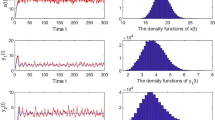Summary
A qualitative analysis of some two and three species predator-prey models is achieved by application of the method of averaging in conjunction with a Lyapunov function constructed from the appropriate Volterra-Lotka model. We calculate the limit cycle solution for a two-species model with a Holling type functional response of the predator to its prey by means of a time-scaled transformation. The existence of a bifurcation of steady states for a community of three species is discussed and the periodic solution around one of the unstable steady states is calculated to the lowest approximation. Several comments are made regarding the behavior of these systems under changes of some control parameters.
Similar content being viewed by others
References
Bogoliubov, N. N., Mitropol'skii, Y. A.: Asymptotic Methods in the Theory of Nonlinear Oscillations. Delhi 6, India: Hindustan Publishing Corp. (1961)
Freedman, H. I., Waltman, P.: Mathematical Analysis of Some Three Species Food Chain Models. Preprint, 1976
Gazis, D. C., Montroll, E. W., Ryniker, J. E.: Age specific, deterministic model of predatorprey populations: Application to Isle Royale. IBM J. Res. Develop. 17, 47–53 (1973)
Gilpin, M. E.: A model of predator-prey interaction. Theor. Pop. Biol. 5, 333–344 (1974)
Goel, N. S., Maitra, S. C., Montroll, E. W.: On the Volterra and other nonlinear models of interacting populations. Rev. Mod. Phys. 43, 231–276 (1971)
Holling, C. S.: The functional response of predators to prey density and its role in mimicry and population regulation. Mem. Entomol. Soc. Can. 45, 1–60 (1965)
Ivlev, V. S.: Experimental Ecology of the Feeding of Fishes. New Haven: Yale University Press (1961)
Kerner, E. H.: A statistical mechanics of interacting biological species. Bull. Math. Biophys. 19, 121–146 (1957)
Koch, A. L.: Competitive coexistence of two predators utilizing the same prey under constant environmental conditions. J. Theor. Biol. 44, 387–395 (1974)
Lin, J., Kahn, P. B.: Averaging methods in predator-prey systems, and related biological models. J. Theor. Biol. 57, 73–102 (1976)
Lin, J., Kahn, P. B.: Qualitative behavior of predator-prey communities. J. Theor. Biol. 65, 101–132 (1977)
Maly, E. J.: Interactions among the predatory rotifier Asplanchna and two prey, Paramecium and Euglena. Ecology 56, 346–358 (1975)
Marsden, J. E., McCracken, M.: The Hopf Bifurcation and Its Applications. New York: Springer (1976)
May, R. M.: Stability and Complexity in Model Ecosystems. Princeton: Princeton University Press (1973)
Minorsky, N.: Nonlinear Oscillations. Princeton: Van Nostrand (1962)
Montroll, E. W.: On coupled rate equations with quadratic nonlinearities. Proc. Nat. Acad. Sci. 69, 2532–2536 (1972)
Rosenzweig, M.: Why the prey curve has a hump. Amer. Natur. 103, 81–87 (1969)
Rosenzweig, M.: Paradox of enrichment: Destabilization of exploitation ecosystems in ecological time. Science 171, 385–387 (1971)
Rosenzweig, M.: Exploitation in three trophic levels. Amer. Natur. 107, 275–294 (1973)
Ruelle, D., Takens, F.: On the nature of turbulence. Comm. Math. Phys. 20, 167–192 (1971)
Smale, S.: On the differential equations of species in competition. J. Math. Biol. 3, 5–7 (1976)
Sutherland, J. P.: Multiple stable points in natural communities. Amer. Natur. 108, 859–873 (1974)
Wollkind, D. J.: Exploitation in three trophic levels: An extension allowing intraspecific carnivore interaction. Amer. Natur. 110, 431–447 (1976)
Author information
Authors and Affiliations
Additional information
This work was supported in parts by USERDA, Contract number E(11-1)-3001.
Rights and permissions
About this article
Cite this article
Lin, J., Kahn, P.B. Qualitative dynamics of three species predator-prey systems. J. Math. Biology 5, 257–268 (1978). https://doi.org/10.1007/BF00276121
Received:
Issue Date:
DOI: https://doi.org/10.1007/BF00276121




